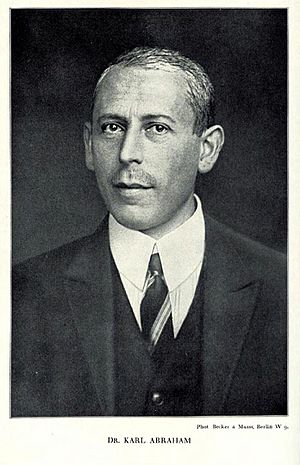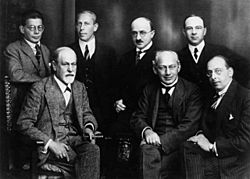Karl Abraham facts for kids
Quick facts for kids
Karl Abraham
|
|
|---|---|
 |
|
| Born | 3 May 1877 |
| Died | 25 December 1925 (aged 48) |
| Scientific career | |
| Fields | Psychiatry |
Karl Abraham (German: [ˈaːbʁaham]; 3 May 1877 – 25 December 1925) was an influential German psychoanalyst, and a collaborator of Sigmund Freud, who called him his 'best pupil'.
Contents
Life
Abraham was born in Bremen, Germany. His parents were Nathan Abraham, a Jewish religion teacher (1842–1915), and his wife (and cousin) Ida (1847–1929). His studies in medicine enabled him to take a position at the Burghölzli Swiss Mental Hospital, where Eugen Bleuler practiced. The setting of this hospital initially introduced him to the psychoanalysis of Carl Gustav Jung.
Collaborations
In 1907, he had his first contact with Sigmund Freud, with whom he developed a lifetime relationship. Returning to Germany, he founded the Berliner Society of Psychoanalysis in 1910. He was the president of the International Psychoanalytical Association from 1914 to 1918 and again in 1925.
Karl Abraham collaborated with Freud on the understanding of manic-depressive illness, leading to Freud's paper on 'Mourning and Melancholia' in 1917. He was the analyst of Melanie Klein during the years 1924–1925, and of a number of other British psychoanalysts, including Edward Glover and Alix Strachey. He was a mentor for an influential group of German analysts, including Karen Horney, Helene Deutsch, and Franz Alexander.
Abraham (1920) also showed interest in cultural issues. He analyzed various myths suggesting their relation to dreams (1909) and wrote an interpretation of the spiritual activities of the Egyptian monotheistic Pharaoh Amenhotep IV (1912).
Death

Abraham died prematurely on December 25, 1925, from complications of a lung infection and may have suffered from lung cancer.
See also
 In Spanish: Karl Abraham para niños
In Spanish: Karl Abraham para niños

